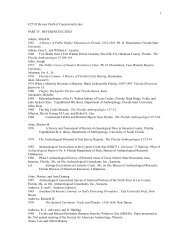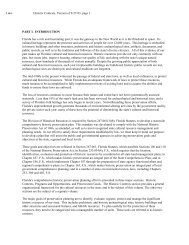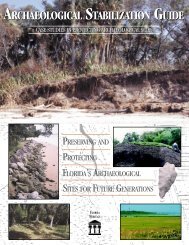Conservation Easements: Protecting Archaeological Sites and ...
Conservation Easements: Protecting Archaeological Sites and ...
Conservation Easements: Protecting Archaeological Sites and ...
You also want an ePaper? Increase the reach of your titles
YUMPU automatically turns print PDFs into web optimized ePapers that Google loves.
What are the tax incentives for conveyingan easement?Three types of tax benefits are available to owners who wish to place theirproperty under a protective easement. These are:1. Property taxesPlacing a property under an easement lowers the property’s fair market valuebecause it restricts the use of the l<strong>and</strong>. This can result in a reduction ofproperty taxes. State <strong>and</strong> local law as well as individual tax assessmentdetermine the amount of this reduction. Florida law requires propertyappraisers to recognize the reduced market value of a property undereasement. (See Sections 193.501 <strong>and</strong> 193.503, Florida Statutes).2. Estate taxes<strong>Conservation</strong> easements allow families to permanently protect their l<strong>and</strong>without giving up ownership. Children who have inherited l<strong>and</strong> from theirfamilies often cannot afford the estate taxes <strong>and</strong> are forced to sell it. Byplacing an easement on family l<strong>and</strong> that restricts its future development, theproperty’s overall value is reduced, which results in lower taxes.3. Federal income taxesA property owner who donates a conservation easement may be eligible for afederal income tax deduction if the property under easement meets specificcriteria. According to the IRS code, to be eligible for a federal income taxdeduction, the easement must be donated in perpetuity to a qualifiedorganization such as an historical society or a l<strong>and</strong> trust, <strong>and</strong> for conservationpurposes only. The IRS code allows tax deductions for donation ofconservation easements in five resource categories:1. public recreation <strong>and</strong>/or education2. significant natural resource3. scenic enjoyment4. pursuant to local government policy5. historic preservationTwo types of cultural resources qualify for historic preservation income taxdeductions. These are a “historically important l<strong>and</strong> area” <strong>and</strong> a “certifiedhistoric structure.” To be considered “historically important,” properties must<strong>Conservation</strong> <strong>Easements</strong>: <strong>Protecting</strong> <strong>Archaeological</strong> <strong>Sites</strong> <strong>and</strong> Historic Buildings on Private L<strong>and</strong>s 9














